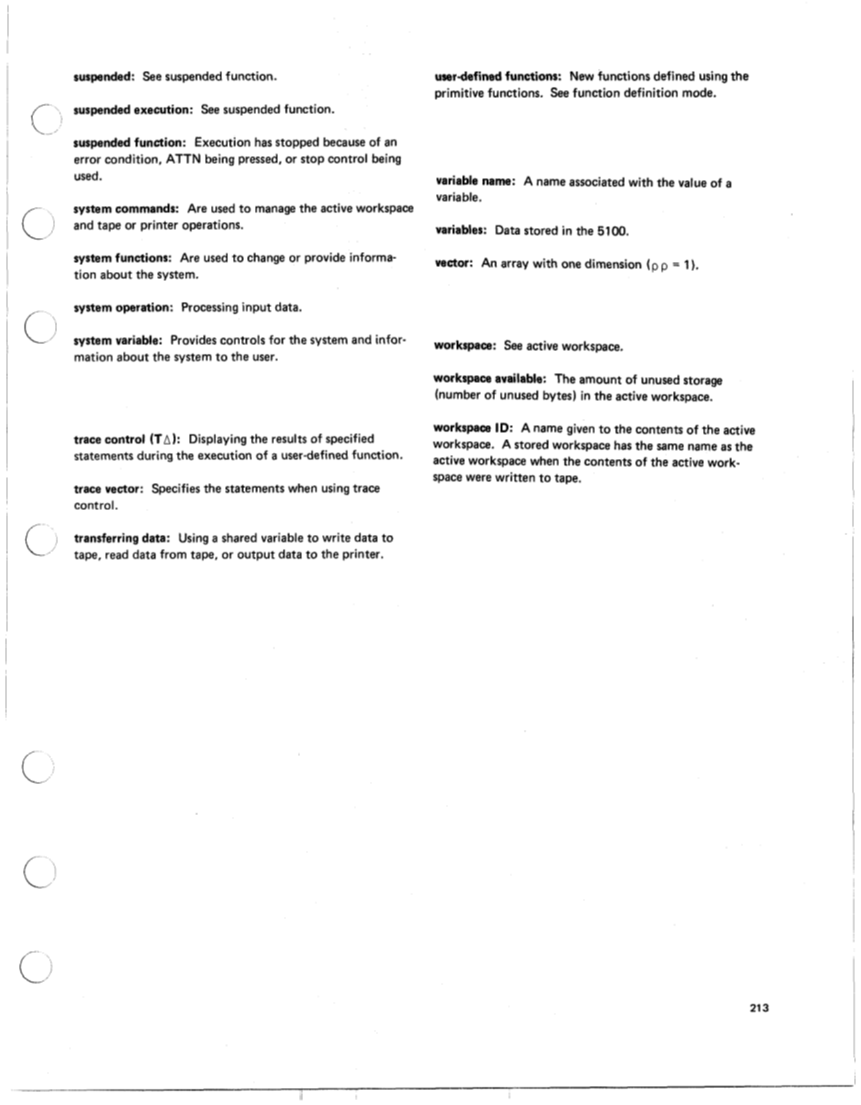output: The results of statements processed by the 51 00.
overstruck character: A character formed by entering one
character, backspacing, and entering another character.
Only certain combinations of characters can form over-
struck characters.
parameter: (1 1 Information needed by a system command
(such as device/file number). (2) Information required to
open a data file or specify printer output.
password: A sequence of characters that must be matched
before the contents of a stored workspace can be loaded or
copied into the active workspace.
pendent function: Any function in the state indicator list
that is not a suspended function.
physical record: A 512-byte block of storage on tape.
plane: The coordinates of an n-rank array other than the
rows and columns.
primitive function: The functions that are part of the APL
language (such as, + - f XI.
PRT operation: Using a shared variable to output data on
the printer.
rank: The number of coordinates of an array (p p).
record: Data assigned to a shared variable.
result variable: A variable to the left of the assignment
arrow in the function header where the results of the func-
tion are temporarily stored for use in further calculations.
return code: Assigned to a shared variable after a PRT,
OUT, or ADD operation. This code indicates whether or
not the operation was successful.
scalar: A single data item that does not have a dimension
(pp = 0).
scalar function: The results of the scalar functions are the
same shape as the arguments.
scale: An integer representing the power of ten when
scaled representation is used.
scaled representation: Stating a value in a convenient
range and multiplying it by the appropriate power of ten.
scroll: Moving the information on the display screen up or
down.
shape: The length of each coordinate of an array.
shared variables: A variable shared by the active workspace
and the tape or printer. Used to transfer data during IN,
OUT, ADD, or PRT operations.
significant digit: * A digit that is needed for a certain pur-
pose, particularly one that must be kept to preserve a spe-
cific accuracy or precision.
singleelement array: A single data item that has at least
one coordinate. For example, a matrix with one row and
one column.
state indicator: Contains information on the progress
(statement number of the statement being executed) of
user-defined function execution. Can be displayed to show
all suspended and pendent user-defined functions.
statement: A numbered instruction within a user-defined
function.
statement number: The number of a statement within a
user-defined function.
stop control (SA): Stopping execution of a user-defined
function before the execution of a specified statement.
stop vector: Specifies the statements when using stop
control.
.>
stored workspace: The contents of the active workspace
stored on tape.
21 2
overstruck character: A character formed by entering one
character, backspacing, and entering another character.
Only certain combinations of characters can form over-
struck characters.
parameter: (1 1 Information needed by a system command
(such as device/file number). (2) Information required to
open a data file or specify printer output.
password: A sequence of characters that must be matched
before the contents of a stored workspace can be loaded or
copied into the active workspace.
pendent function: Any function in the state indicator list
that is not a suspended function.
physical record: A 512-byte block of storage on tape.
plane: The coordinates of an n-rank array other than the
rows and columns.
primitive function: The functions that are part of the APL
language (such as, + - f XI.
PRT operation: Using a shared variable to output data on
the printer.
rank: The number of coordinates of an array (p p).
record: Data assigned to a shared variable.
result variable: A variable to the left of the assignment
arrow in the function header where the results of the func-
tion are temporarily stored for use in further calculations.
return code: Assigned to a shared variable after a PRT,
OUT, or ADD operation. This code indicates whether or
not the operation was successful.
scalar: A single data item that does not have a dimension
(pp = 0).
scalar function: The results of the scalar functions are the
same shape as the arguments.
scale: An integer representing the power of ten when
scaled representation is used.
scaled representation: Stating a value in a convenient
range and multiplying it by the appropriate power of ten.
scroll: Moving the information on the display screen up or
down.
shape: The length of each coordinate of an array.
shared variables: A variable shared by the active workspace
and the tape or printer. Used to transfer data during IN,
OUT, ADD, or PRT operations.
significant digit: * A digit that is needed for a certain pur-
pose, particularly one that must be kept to preserve a spe-
cific accuracy or precision.
singleelement array: A single data item that has at least
one coordinate. For example, a matrix with one row and
one column.
state indicator: Contains information on the progress
(statement number of the statement being executed) of
user-defined function execution. Can be displayed to show
all suspended and pendent user-defined functions.
statement: A numbered instruction within a user-defined
function.
statement number: The number of a statement within a
user-defined function.
stop control (SA): Stopping execution of a user-defined
function before the execution of a specified statement.
stop vector: Specifies the statements when using stop
control.
.>
stored workspace: The contents of the active workspace
stored on tape.
21 2









































































































































































































































